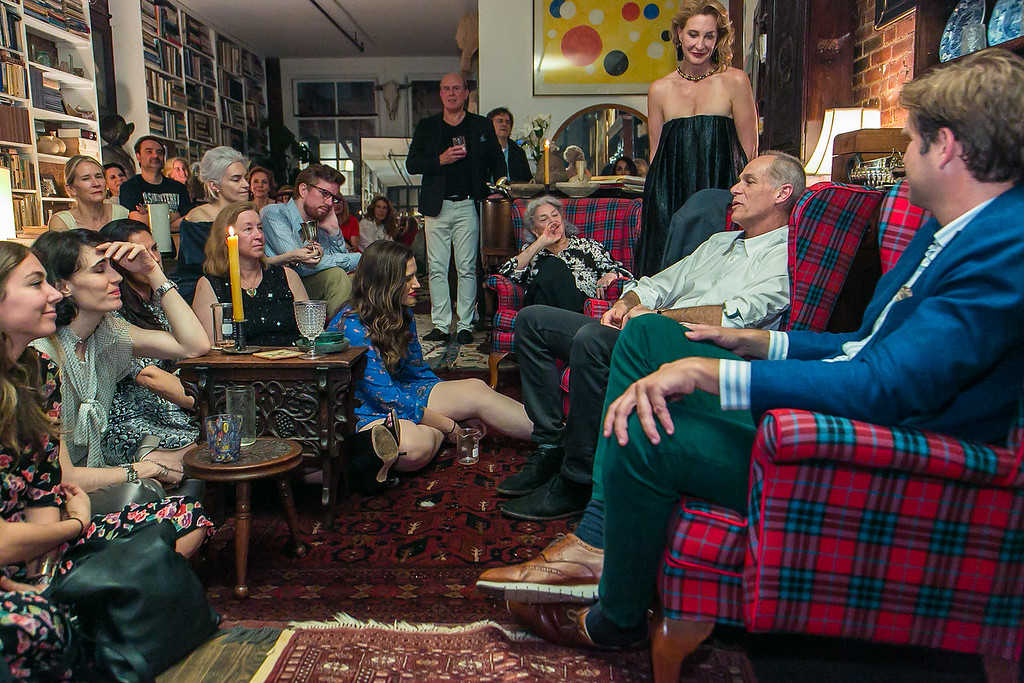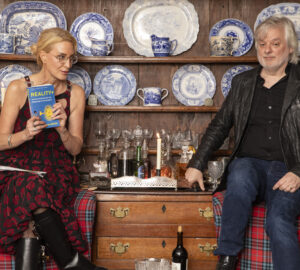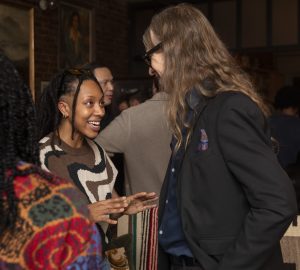Everything about Paul Miller a.k.a. DJ Spooky’s upbringing and career, all the way down to his artist name choice, have seemingly positioned him as the perfect candidate for Yale Quantum Institute’s (YQI) artist-in-residence program – some might even say super-positioned him! Forgive us in advance for the quantum puns, they’re all right there in the unified field just waiting to be noticed. But for you non-quantum geeks out there, Einstein famously observed quantum particle entanglement as “spooky action at a distance.” Once two particles have interacted, or become “entangled,” they are forever connected and can exchange information instantaneously. There is quite literally a quantum explanation for why our face-to-face conversations are so impactful, even if we don’t stay in touch once we’ve entangled we’ve forever affected each other!
“I’ve always felt like I wasn’t that interested in hanging out in the music scene as much as I was interested in being around really well-read people who are into science want to talk about ideas. I like to have one foot in each world,” Paul explained when I asked how he ended up at YQI. His parents were both professors, so he’s always had a passion and natural place in academia, plus he’s a wildly well-read science fiction guy and says that very much influenced his approach to music. “Music for me isn’t music, I always like to say it’s kind of like you’re playing with patterns, but once you really think about it, patterns are math and math can be a tuning system. So you have to strike a fine balance between accessibility and experimentation, and I’ve always tried to navigate that.”
The accessibility apsect is now, according to Paul, a front-burner issue. “It’s so critical for science to have a relationship with the arts, especially right now going into 2022 when science is being popularly denied. The more science is a part of our day-to-day lives the more we can help combat that, and I think music can play a big role in shepherding this idea to mass culture.” Creating opportunities for entanglement between science and the general public, he contends, brings about a natural shift in consciousness. And Paul’s been on this mission for awhile, previously worked on a project with physicist and past salon guest speaker Marcelo Gleiser of Dartmouth where he had Marcelo write poetry he put music to about the observable universe, as well as a concert series with Stephon Alexander also of Dartmouth who wrote The Jazz of Physics about what he calls ‘the tunable universe.’

The idea of the tunable universe uses music as a metaphor for the inner-workings of quantum physics by going all the way back to a term to Greek philosopher Pythagoras, who observed that the relative distance between planets were akin to musical intervals, and the result must therefore be a harmony. This idea inspired the world’s first astro-physicist and astronomer Johannes Kepler to assign musical notes the ratio of every planet’s distance from the sun in order to develop his three laws of planetary motion, which are still used to put satellites in orbit today, and what he came up with were musical scales. Paul’s presence in the department also has the effect of tuning his physicist collaborators to the history and artistic leanings of their most influential predecessors. By placing the entanglement between physics pioneers and their sources of inspiration at the forefront of the conversation, he’s made it part of his mission to bring up the books everyone from Newton to Heisenberg were most inspired by.
“The spirit of inquiry is always engaging with new approaches to things, and that’s the spirit of the program,” Paul says. “For example, so many scientists were fascinated with The Upanishads, (ancient Hindu Sanskrit texts), and it’s pretty wild to get into thinking about that influence, because the science is catching up to some of these more mystical beliefs about the infinite multiverse.” By studying the Hindu mythology that inspired Schrödinger or reading German philsophy that influenced Einstein, Paul hopes to bring another layer of understanding to the table as he works on designing residency project. “As I’m going back and forth with these scientists, I want to make sure they remember the scientists they’re referencing were also reading other stuff, they weren’t just looking at equations. It feels important to bring into the foreground.”
According to Paul these books, the threads of inspiration that inspired physics’ most innovative minds, are inherently entangled in the math itself, and thus perhaps quantum leaps in understanding can be made by simply reading those old texts and thereby tuning in to the frequency of that original inspiration. Paul’s collaborator Stephon Alexander in his TED Talk about the musical universe discusses the inexplicable mystery of what would happen when he’d take his physics homework to jazz clubs – sitting there listening to the music he would begin inexplicably solving equations that had been baffling him.
So we’ve identified that human interaction creates quantum entanglement and that it can generate leaps in understanding, we’ve given you every resource we have on how to host a salon, and now it’s up to you. We’ll be following closely as Paul executes his vision of designing a project that is both accessible and experimental, no doubt it will be fascinating and true to his mission of making science a cool talking point in pop culture. Spooky action at a distance is at work anytime we influence each other even in the slightest way, so in a time when we’re being flooded with negativity online and in the media generally, some IRL facetime to have some juicy, thought-provoking conversations really matters. Read all about the Yale Quantum Institute’s artist residency program and follow Paul @DjSpooky on Twitter. Follow us while you’re at it @TheSalonHost !! And be sure to watch Paul’s Ted Salon talk from 2020 to learn about yet another fabulous quantum sonic project called ‘Quantopia’ with the San Francisco Girls Chorus and UC Berkeley data artist Greg Niemeyer.



